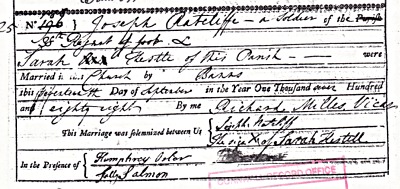|
After the Peace was signed in 1783, the 38th came home from North America, having suffered severe losses at the Battle for Bunker Hill in 1775, and thereafter seen very little action having been stationed at New York and Nova Scotia (Jones). To encourage local patriotism and to improve recruiting, infantry regiments were given a territorial designation and in 1782 the 38th was appointed to the county of Stafford and named as "First Staffordshire". (Vale)
Morale was low and the regiment was under strength when Shropshire-born Joseph enlisted in the First Staffordshire Regiment as a private at Stafford on 27th March 1784 (National Archives). First recorded as John Ratcliff he was recruited into Capt. Hugh Maginis' Company and transferred into William Davies' Company about two months later, on 24th May, now listed as 'Joseph' Ratcliff.
On the 5th June, under the command of Lieut.-General Sir Robert Pigot, their Colonel-in-Chief, the Regiment was inspected at Stafford. They numbered 238 men, of whom 151 were English, 18 Scotch, 57 Irish, and 12 Foreigners; 112 of them had served for upwards of 10 years. The foreigners were probably coloured bandsmen (Vale); it was very common in those days for drummers to be recruited in the West Indies. The report was surprisingly complimentary about recruits and recruiting given that the Regiment was seriously under-strength:
"Officers. A good Corps. Salute pretty well, very attentive, and Uniform conformable to Regulations.
N.C.O.'s. Of good appearance, attentive and expert.
Men. Good, mostly veterans. Recruits good. Marched pretty well, time rather fast, Manual rather quick.
Arms. In general bad and many wanting.
General Observations. This Regiment appears to be very diligent as well in recruiting as forming their men. The system in general such as promises to lay the foundations of a very serviceable Regiment.
Signed, Geo, Warde, Lieut.-General." (Jones) |
Later in 1784 the Regiment moved to Chatham where Joseph served as a Private apart from a brief time as Corporal between 12th March and 20th August 1787. The day after being made up to Corporal he was granted a week's furlough on Lieutenant-Colonel's leave. On the 21st August, the day after being reduced from Corporal, he went sick (National Archives).
An inspection in 1787 (Jones) noted that the Regiment marched "in slow time, slower than the Regulation" but "remarkably well in Line and gain much ground in their movements." Despite their smartness in recruiting, 70 newly enlisted men had deserted, "chiefly Staffordshire men and men from Wolverhampton." An inspection the following year gave a very satisfactory report.

In 1788 the Regiment moved to Plymouth. Joseph met Sarah Kestle while he was on detachment recruiting at Truro during the first 6 months of that year. He must have looked handsome in his redcoat uniform, smartly presented to encourage recruits. They married at Kenwyn on 17th September 1788 (Kenwyn Marriage Register). If Sarah had been pregnant at the time of their marriage she must have miscarried soon after for there is no record of a birth. The 38th remained at Plymouth throughout 1789 and Joseph and Sarah may well have lived on the Rame Peninsula. Troops were often quartered at Cawsand and at Maker Heights overlooking Plymouth Sound, where redoubts and barracks had been built by the Duke of Richmond in the 1770s and 1780s as a protection against the rise of the American Navy during the American War for Independence.
On July 14th 1789, the French Revolution was sparked when a Parisian mob stormed the Bastille. Britain breathed a sigh of relief, believing that the military threat from France was over.
In 1790 the 38th was posted to Galway. Pension rates on discharge in Ireland were much lower, so most of the veterans with loyal service were allowed to stay behind in England and the Regiment lost a high proportion of its best trained men. They landed at Cork and marched 120 miles north to Galway; Joseph was based 30 miles further north at Ballinrobe. The 38th transferred to Dublin barracks later that year and Joseph was discharged on 6th September 1791 (National Archives) .
- Jones, James P, A History of the South Staffordshire Regiment (1705-1923)
 , Whitehead Brothers (Wolverhampton) 1923 , Whitehead Brothers (Wolverhampton) 1923
- National Archives, General Muster Books and Pay Lists, 38th Foot 1st Battalion, WO12/5171&2 (1760-1778), WO12/5172 (1779-1788), WO12/5173 (1789-1798)
- Vale, W.L., Chapter V of History of the South Staffordshire Regiment
 , Gale & Polden, Aldershot 1969.
, Gale & Polden, Aldershot 1969.
|



